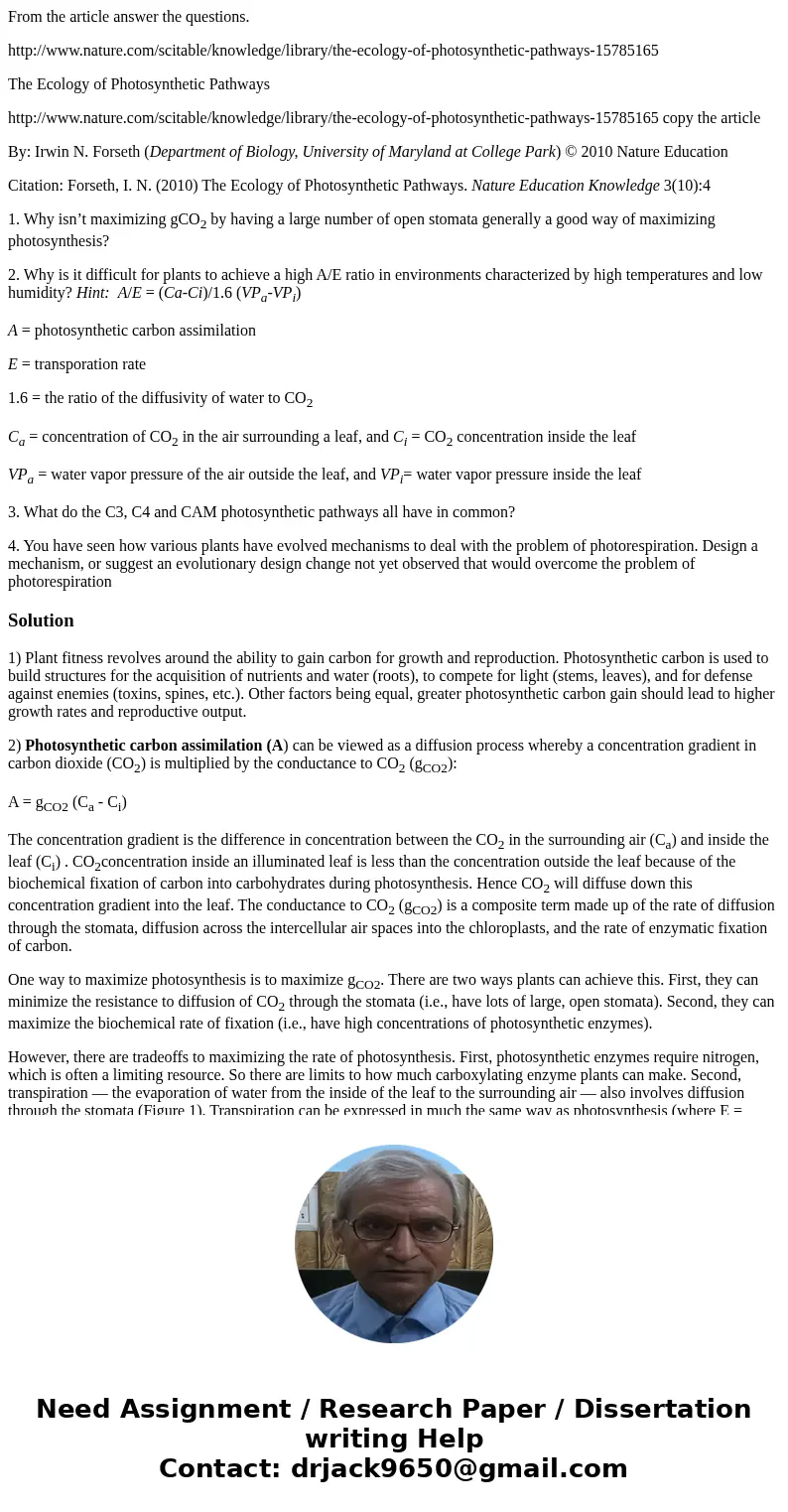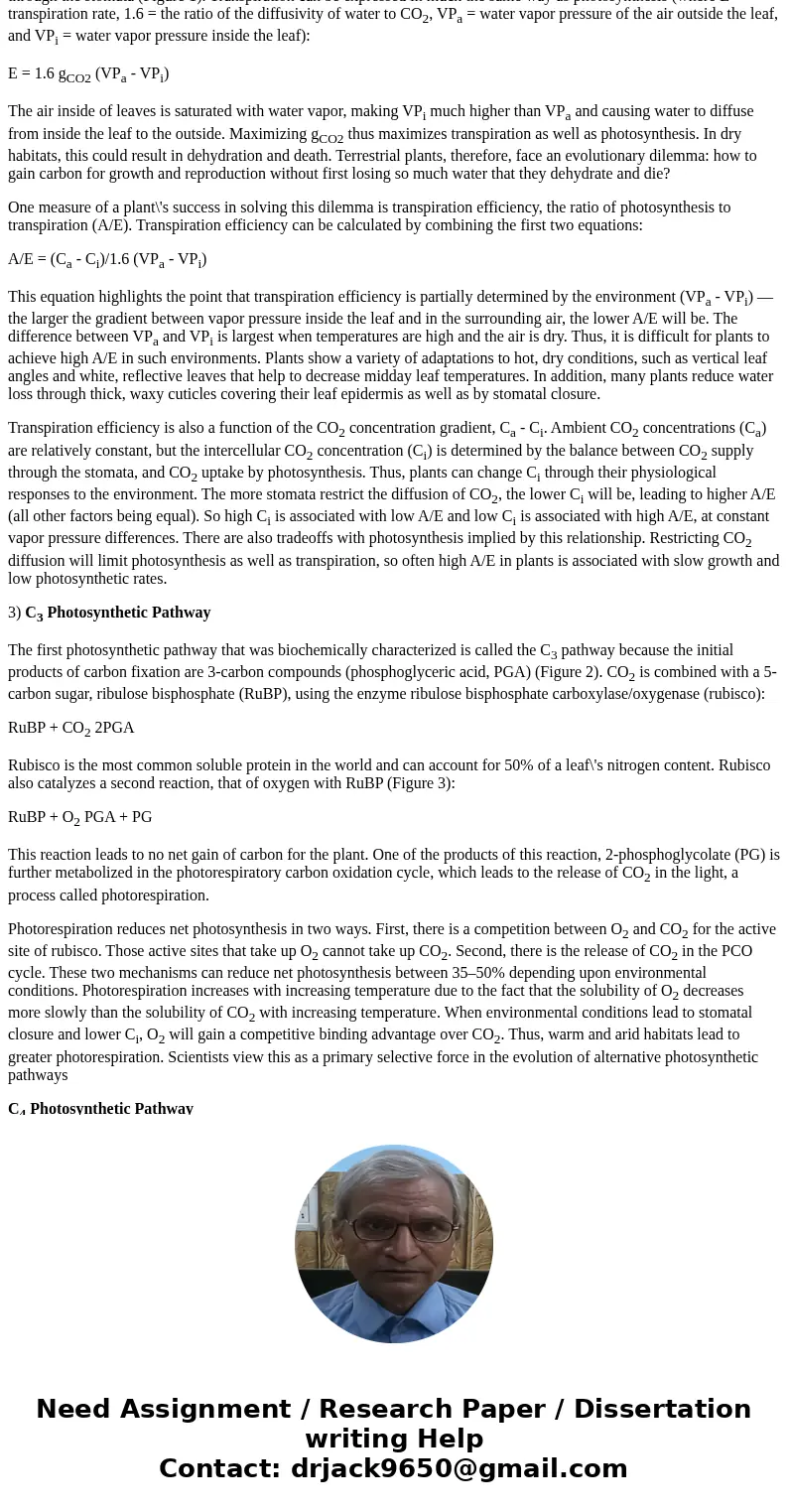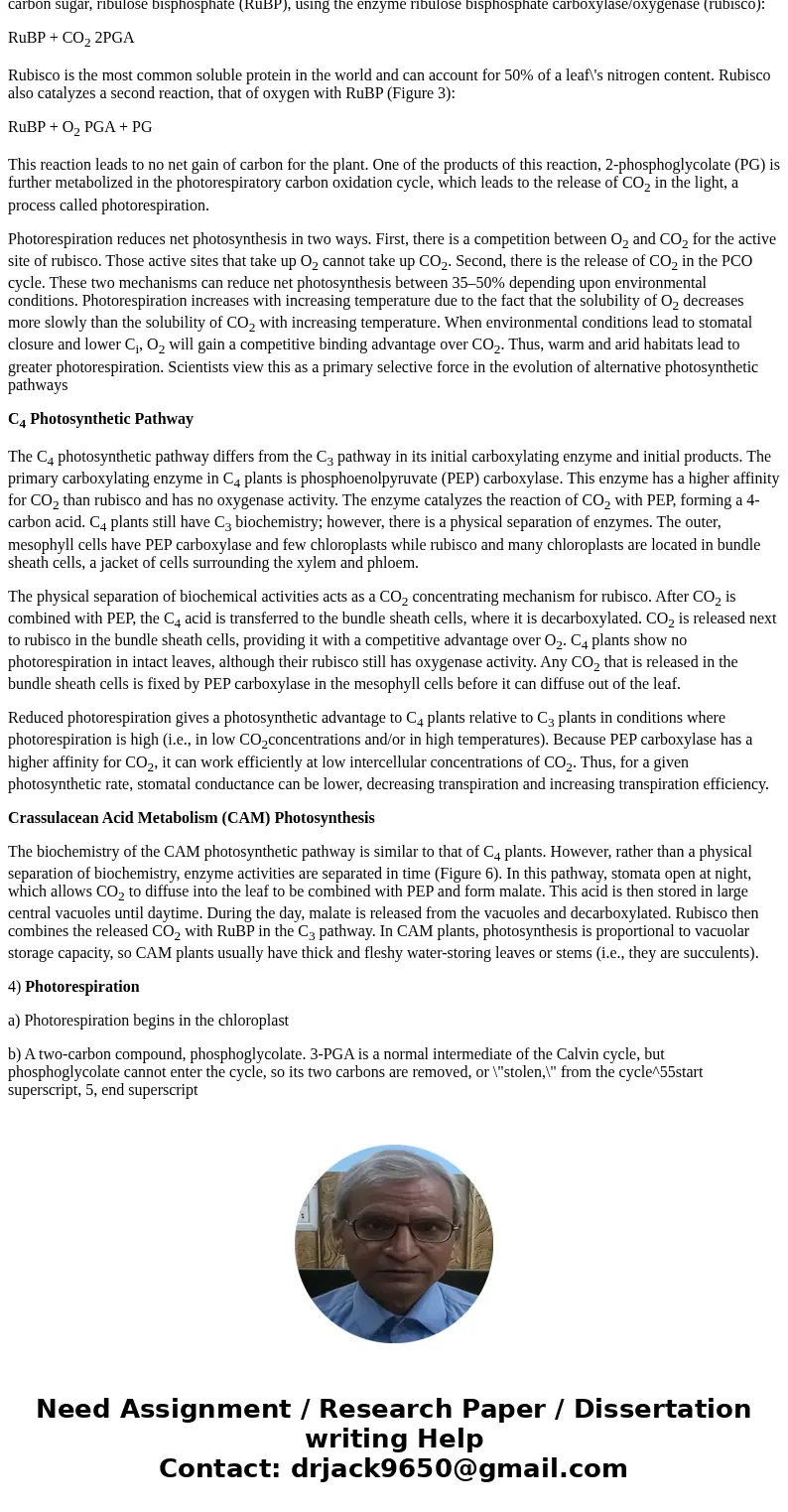From the article answer the questions httpwwwnaturecomscitab
From the article answer the questions.
http://www.nature.com/scitable/knowledge/library/the-ecology-of-photosynthetic-pathways-15785165
The Ecology of Photosynthetic Pathways
http://www.nature.com/scitable/knowledge/library/the-ecology-of-photosynthetic-pathways-15785165 copy the article
By: Irwin N. Forseth (Department of Biology, University of Maryland at College Park) © 2010 Nature Education
Citation: Forseth, I. N. (2010) The Ecology of Photosynthetic Pathways. Nature Education Knowledge 3(10):4
1. Why isn’t maximizing gCO2 by having a large number of open stomata generally a good way of maximizing photosynthesis?
2. Why is it difficult for plants to achieve a high A/E ratio in environments characterized by high temperatures and low humidity? Hint: A/E = (Ca-Ci)/1.6 (VPa-VPi)
A = photosynthetic carbon assimilation
E = transporation rate
1.6 = the ratio of the diffusivity of water to CO2
Ca = concentration of CO2 in the air surrounding a leaf, and Ci = CO2 concentration inside the leaf
VPa = water vapor pressure of the air outside the leaf, and VPi= water vapor pressure inside the leaf
3. What do the C3, C4 and CAM photosynthetic pathways all have in common?
4. You have seen how various plants have evolved mechanisms to deal with the problem of photorespiration. Design a mechanism, or suggest an evolutionary design change not yet observed that would overcome the problem of photorespiration
Solution
1) Plant fitness revolves around the ability to gain carbon for growth and reproduction. Photosynthetic carbon is used to build structures for the acquisition of nutrients and water (roots), to compete for light (stems, leaves), and for defense against enemies (toxins, spines, etc.). Other factors being equal, greater photosynthetic carbon gain should lead to higher growth rates and reproductive output.
2) Photosynthetic carbon assimilation (A) can be viewed as a diffusion process whereby a concentration gradient in carbon dioxide (CO2) is multiplied by the conductance to CO2 (gCO2):
A = gCO2 (Ca - Ci)
The concentration gradient is the difference in concentration between the CO2 in the surrounding air (Ca) and inside the leaf (Ci) . CO2concentration inside an illuminated leaf is less than the concentration outside the leaf because of the biochemical fixation of carbon into carbohydrates during photosynthesis. Hence CO2 will diffuse down this concentration gradient into the leaf. The conductance to CO2 (gCO2) is a composite term made up of the rate of diffusion through the stomata, diffusion across the intercellular air spaces into the chloroplasts, and the rate of enzymatic fixation of carbon.
One way to maximize photosynthesis is to maximize gCO2. There are two ways plants can achieve this. First, they can minimize the resistance to diffusion of CO2 through the stomata (i.e., have lots of large, open stomata). Second, they can maximize the biochemical rate of fixation (i.e., have high concentrations of photosynthetic enzymes).
However, there are tradeoffs to maximizing the rate of photosynthesis. First, photosynthetic enzymes require nitrogen, which is often a limiting resource. So there are limits to how much carboxylating enzyme plants can make. Second, transpiration — the evaporation of water from the inside of the leaf to the surrounding air — also involves diffusion through the stomata (Figure 1). Transpiration can be expressed in much the same way as photosynthesis (where E = transpiration rate, 1.6 = the ratio of the diffusivity of water to CO2, VPa = water vapor pressure of the air outside the leaf, and VPi = water vapor pressure inside the leaf):
E = 1.6 gCO2 (VPa - VPi)
The air inside of leaves is saturated with water vapor, making VPi much higher than VPa and causing water to diffuse from inside the leaf to the outside. Maximizing gCO2 thus maximizes transpiration as well as photosynthesis. In dry habitats, this could result in dehydration and death. Terrestrial plants, therefore, face an evolutionary dilemma: how to gain carbon for growth and reproduction without first losing so much water that they dehydrate and die?
One measure of a plant\'s success in solving this dilemma is transpiration efficiency, the ratio of photosynthesis to transpiration (A/E). Transpiration efficiency can be calculated by combining the first two equations:
A/E = (Ca - Ci)/1.6 (VPa - VPi)
This equation highlights the point that transpiration efficiency is partially determined by the environment (VPa - VPi) — the larger the gradient between vapor pressure inside the leaf and in the surrounding air, the lower A/E will be. The difference between VPa and VPi is largest when temperatures are high and the air is dry. Thus, it is difficult for plants to achieve high A/E in such environments. Plants show a variety of adaptations to hot, dry conditions, such as vertical leaf angles and white, reflective leaves that help to decrease midday leaf temperatures. In addition, many plants reduce water loss through thick, waxy cuticles covering their leaf epidermis as well as by stomatal closure.
Transpiration efficiency is also a function of the CO2 concentration gradient, Ca - Ci. Ambient CO2 concentrations (Ca) are relatively constant, but the intercellular CO2 concentration (Ci) is determined by the balance between CO2 supply through the stomata, and CO2 uptake by photosynthesis. Thus, plants can change Ci through their physiological responses to the environment. The more stomata restrict the diffusion of CO2, the lower Ci will be, leading to higher A/E (all other factors being equal). So high Ci is associated with low A/E and low Ci is associated with high A/E, at constant vapor pressure differences. There are also tradeoffs with photosynthesis implied by this relationship. Restricting CO2 diffusion will limit photosynthesis as well as transpiration, so often high A/E in plants is associated with slow growth and low photosynthetic rates.
3) C3 Photosynthetic Pathway
The first photosynthetic pathway that was biochemically characterized is called the C3 pathway because the initial products of carbon fixation are 3-carbon compounds (phosphoglyceric acid, PGA) (Figure 2). CO2 is combined with a 5-carbon sugar, ribulose bisphosphate (RuBP), using the enzyme ribulose bisphosphate carboxylase/oxygenase (rubisco):
RuBP + CO2 2PGA
Rubisco is the most common soluble protein in the world and can account for 50% of a leaf\'s nitrogen content. Rubisco also catalyzes a second reaction, that of oxygen with RuBP (Figure 3):
RuBP + O2 PGA + PG
This reaction leads to no net gain of carbon for the plant. One of the products of this reaction, 2-phosphoglycolate (PG) is further metabolized in the photorespiratory carbon oxidation cycle, which leads to the release of CO2 in the light, a process called photorespiration.
Photorespiration reduces net photosynthesis in two ways. First, there is a competition between O2 and CO2 for the active site of rubisco. Those active sites that take up O2 cannot take up CO2. Second, there is the release of CO2 in the PCO cycle. These two mechanisms can reduce net photosynthesis between 35–50% depending upon environmental conditions. Photorespiration increases with increasing temperature due to the fact that the solubility of O2 decreases more slowly than the solubility of CO2 with increasing temperature. When environmental conditions lead to stomatal closure and lower Ci, O2 will gain a competitive binding advantage over CO2. Thus, warm and arid habitats lead to greater photorespiration. Scientists view this as a primary selective force in the evolution of alternative photosynthetic pathways
C4 Photosynthetic Pathway
The C4 photosynthetic pathway differs from the C3 pathway in its initial carboxylating enzyme and initial products. The primary carboxylating enzyme in C4 plants is phosphoenolpyruvate (PEP) carboxylase. This enzyme has a higher affinity for CO2 than rubisco and has no oxygenase activity. The enzyme catalyzes the reaction of CO2 with PEP, forming a 4-carbon acid. C4 plants still have C3 biochemistry; however, there is a physical separation of enzymes. The outer, mesophyll cells have PEP carboxylase and few chloroplasts while rubisco and many chloroplasts are located in bundle sheath cells, a jacket of cells surrounding the xylem and phloem.
The physical separation of biochemical activities acts as a CO2 concentrating mechanism for rubisco. After CO2 is combined with PEP, the C4 acid is transferred to the bundle sheath cells, where it is decarboxylated. CO2 is released next to rubisco in the bundle sheath cells, providing it with a competitive advantage over O2. C4 plants show no photorespiration in intact leaves, although their rubisco still has oxygenase activity. Any CO2 that is released in the bundle sheath cells is fixed by PEP carboxylase in the mesophyll cells before it can diffuse out of the leaf.
Reduced photorespiration gives a photosynthetic advantage to C4 plants relative to C3 plants in conditions where photorespiration is high (i.e., in low CO2concentrations and/or in high temperatures). Because PEP carboxylase has a higher affinity for CO2, it can work efficiently at low intercellular concentrations of CO2. Thus, for a given photosynthetic rate, stomatal conductance can be lower, decreasing transpiration and increasing transpiration efficiency.
Crassulacean Acid Metabolism (CAM) Photosynthesis
The biochemistry of the CAM photosynthetic pathway is similar to that of C4 plants. However, rather than a physical separation of biochemistry, enzyme activities are separated in time (Figure 6). In this pathway, stomata open at night, which allows CO2 to diffuse into the leaf to be combined with PEP and form malate. This acid is then stored in large central vacuoles until daytime. During the day, malate is released from the vacuoles and decarboxylated. Rubisco then combines the released CO2 with RuBP in the C3 pathway. In CAM plants, photosynthesis is proportional to vacuolar storage capacity, so CAM plants usually have thick and fleshy water-storing leaves or stems (i.e., they are succulents).
4) Photorespiration
a) Photorespiration begins in the chloroplast
b) A two-carbon compound, phosphoglycolate. 3-PGA is a normal intermediate of the Calvin cycle, but phosphoglycolate cannot enter the cycle, so its two carbons are removed, or \"stolen,\" from the cycle^55start superscript, 5, end superscript



 Homework Sourse
Homework Sourse